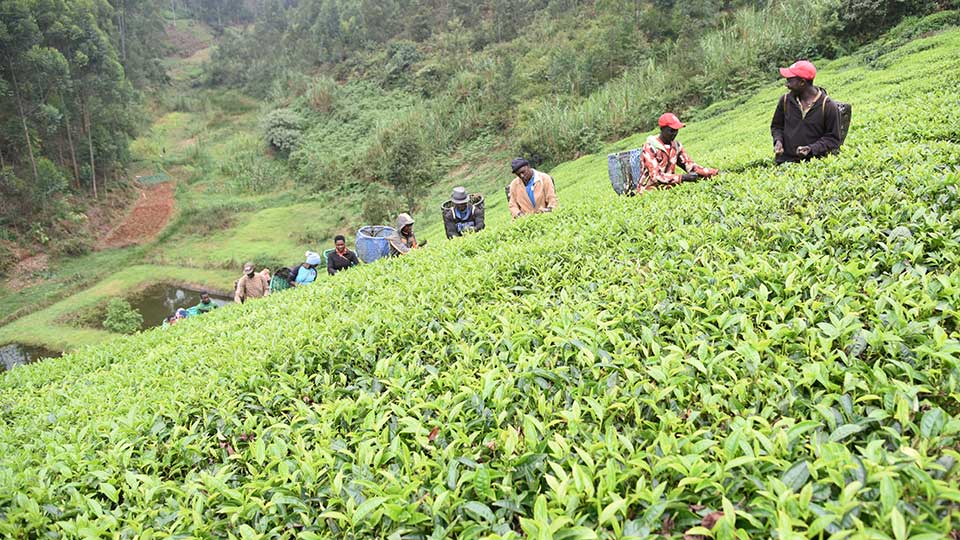Kenya’s Tea Fields Reveal the Hidden Cost of Climate Volatility
Kenya’s tea output has fallen 11% in 2025, exports are slipping, and prices (USD 2.05/kg) hover near cost as erratic weather, weak demand, and global price shifts strain Africa’s top tea exporter, pressuring the shilling (USD/KES: KES=) and regional supply chains.

Kenya’s tea sector is facing one of its steepest contractions in years as production, exports, and prices fall under the weight of erratic weather, weaker global demand, and shifting commodity flows. In the first seven months of 2025, output dropped 11.5 percent to 322.29 million kilograms, down from 364.13 million a year earlier, according to the Tea Board of Kenya (TBK). July alone saw a 4.3 percent decline to 39.04 million kilograms as dry and cold conditions reduced leaf growth across major tea zones. Factories managed by the Kenya Tea Development Agency (KTDA) recorded a sharper 13.7 percent slump. The decline was driven by below-average rainfall—often below 12 mm per day—and cooler temperatures of 8–21°C, shortening plucking periods and limiting yields across the highlands.
At the Mombasa Tea Auction, traded volumes fell 25.6 percent year-on-year to 25.41 million kilograms, while average prices slipped to USD 2.05/kg from USD 2.21/kg, a 7.2 percent drop. In local terms, tea fetched an average KSh 264.89/kg versus KSh 287.01/kg, a 7.7 percent fall even with a weaker shilling (USD/KES: KES= 156). Smallholder teas averaged USD 2.32/kg, down from USD 2.77/kg, a 16.3 percent decline. Domestic consumption rose 5.1 percent to 2.88 million kilograms, supported by the 2025 Finance Act’s VAT exemptions and packaging incentives for locally grown tea.
Exports tell a mixed story. Shipments reached 55.57 million kilograms in July, up 5 percent from last year, but cumulative exports for January–July dropped 7 percent to 330.19 million kilograms. Pakistan remained Kenya’s top buyer with a 36 percent share, followed by Egypt, the UK, and the UAE. However, UK imports fell 28 percent, while purchases from Oman, Jordan, and Kazakhstan rose. TBK projects total 2025 output at 553 million kilograms, down from 594 million in 2024—a 6.9 percent annual drop if the trend holds. The agency warns that global shipping bottlenecks through the Red Sea and lower European demand could delay recovery even if rains return in Q4.
The slump exposes the fragility of Kenya’s export model. Tea contributes roughly 23 percent of the country’s agricultural export earnings and about 10 percent of global black tea supply. A fall from USD 2.21 to USD 2.05 per kilogram translates to an estimated USD 80 million annualized revenue loss across the value chain. With production costs hovering near USD 1.90/kg, margins are tightening. KTDA-managed factories face cash-flow pressure, and some cooperatives are delaying farmer payouts. For comparison, the Nairobi Securities Exchange (NSE: NSEKE)-listed Williamson Tea Kenya (NSE: WTK) and Kapchorua Tea Kenya (NSE: KAPC) have seen share price declines of 9–12 percent YTD as export earnings soften.
Globally, the tea downturn mirrors broader commodity headwinds. Sri Lanka’s 2024 tea output fell 8 percent, and India’s Darjeeling and Assam regions continue to struggle with irregular monsoons. Kenya’s outsized influence means its supply shocks ripple across global prices. Recent auction averages in Colombo and Kolkata rose 3–5 percent in late Q3 as traders priced in Kenya’s shortfall. Global beverage companies such as Unilever PLC (LSE: ULVR)—owner of Lipton Teas & Infusions—and Associated British Foods (LSE: ABF), which owns Twinings, face rising sourcing costs. These pressures may push them toward diversified African suppliers like Rwanda and Malawi, where costs remain 10–15 percent lower per kilogram.
The regional ripple effect is complex. Uganda, Rwanda, and Tanzania could fill near-term supply gaps if stable output holds, but they face similar weather volatility and rising fertilizer costs. For context, Rwanda’s output rose 6 percent in 2024 to 39 million kilograms, while Tanzania’s plateaued at 33 million. Both countries could see short-term export gains of 4–6 percent if Kenya’s slowdown persists into 2026. Regional initiatives under the East African Community (EAC) and African Continental Free Trade Area (AfCFTA) aim to create integrated export corridors and harmonized grading systems, which could reduce logistics costs by up to 12 percent according to the African Development Bank (AfDB).
The macroeconomic implications extend beyond agriculture. Lower tea earnings threaten Kenya’s balance of payments and foreign reserves, currently estimated at USD 6.8 billion (equivalent to 3.3 months of import cover). A weaker current account could pressure the shilling further, prompting the Central Bank of Kenya (CBK) to intervene through open-market operations or additional Treasury bond issuances. Kenyan Eurobonds maturing in 2032 (ISIN XS2051363054) are trading near 9.2 percent yield, reflecting investor caution. On the equities side, the NSE All Share Index (NSE: NASI) has slipped 4.5 percent YTD as agricultural counters underperform.
Climate volatility adds a structural challenge. With global weather patterns turning more erratic, Kenya risks becoming a case study in how climate risk transmits into commodity markets. Temperatures across East Africa have risen by 1.2°C over the past two decades, reducing rainfall reliability and heightening susceptibility to El Niño cycles. Without investment in irrigation and resilient high-yield clones, tea yields could fall another 8–10 percent by 2030, according to the UN Food and Agriculture Organization (FAO).
Global consumption trends compound the problem. The UK’s 28 percent import drop from Kenya signals structural decline in legacy markets, with European consumers shifting toward herbal, specialty, and decaffeinated blends. Meanwhile, newer markets like China (SSE: 000300) and the Middle East are growing, but price sensitivity remains high. Vietnam and Bangladesh are capitalizing on this shift, expanding black tea exports by 9 and 11 percent respectively in 2024. Unless Kenya accelerates diversification into orthodox, green, and specialty teas, its export base will remain vulnerable to single-market shocks.
Kenya’s 11 percent production drop in 2025 is more than a weather anomaly—it’s a macroeconomic signal. The convergence of climate pressure, global demand shifts, and cost inflation has turned tea, long considered a stable export, into a stress indicator for Africa’s agricultural economies. For investors, policymakers, and global commodity traders, the lesson is clear: soft commodities are no longer immune to hard volatility. Those who adapt through sustainability, supply-chain diversification, and technology will define the next chapter of Africa’s agri-export story.





